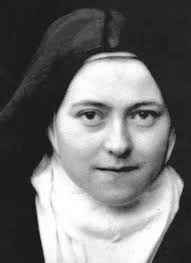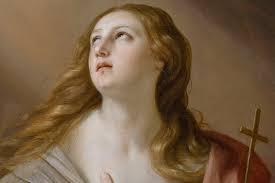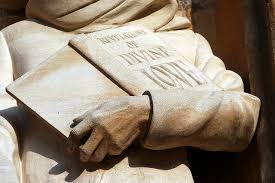St. Thérèse of Lisieux – The Little Flower
There are many stories of how the Little Flower has intervened in the sufferings of ordinary Irish people. Statues and pictures often depict her as a demure saint clutching a bunch of flowers. But is this the real Thérèse or a rather sentimentalised version promoted to fit in with pious notions about how saints should be?

Here at a glance you can see other aspects of Thérèse , which might show her in a more complex but ultimately realistic light:
- As a young nun she found it hard to concentrate during meditation and often fell asleep while praying.
- She questioned the use of extreme mortifications in the convent and felt her ‘little way’ of small kindnesses was a better approach.
- She suffered from scruples for several years but ultimately rejected the commonly held view of God at the time as a ‘harsh judge’.
- In the convent she was at times criticised for being slow at mending and being unaccustomed to housework.
- She came to realise that some priests could be vain and lacking in spiritual depth and saw it as her vocation to pray for priests.
- She herself had longed to be a priest and gave spiritual counsel to two young priests who requested her support.
The Early Years
Born into a well-to-do family in Alençon in Normandy, France in 1873, they later moved to Lisieux after the death of her mother when Thérèse was only four and a half. This early loss predisposed Thérèse to regular outbursts of emotionality. The loss was compounded by the subsequent loss of her sister Pauline who, having become a virtual second mother to Thérèse, left home to enter the Carmelite convent of Lisieux when Thérèse was only eleven. This new crisis was later followed by the departure of another older sister Marie, for the same convent when Thérèse was thirteen. Thérèse herself after much pleading, would receive special permission to enter the convent herself when she was only fifteen.

These setbacks proved to be a testing ground for Thérèse who by the age of fourteen endeavoured to put behind her the emotional outbursts of childhood after she was deeply influenced by the austere spiritual writings of Thomas à Kempis’ “The Imitation of Christ”.
The Outer Life
Towards the beginning of Patricia O’Connor’s insightful book “In Search of Thérèse”, she advises that we ‘must first get beyond the language of sanctity” in order to uncover the identity of the real Thérèse. In fact even her own sisters were slow to see beyond the notion they had of their younger sister as the ‘baby’ of the family. Her initial spiritual advisor in the convent, Father Pichon according to Thérèse herself “treated me too much like a child”. It was really only in Thérèse’s years of serious illness brought about by her tuberculosis, that her older sister Pauline remarked:
I have known a good many really fervent Carmelites, nuns who loved God and feared to offend him, but Sister Therese’s state of soul was so different from what I have seen in others that they seem to have nothing in common.
So what was different about her? She was often deliberately humiliated by her superior, Mother Marie de Gonzague who believed firmly that ‘humiliations’ strengthen the soul. She also had to put up with the hostility of Sister Aimée who disapproved of the influence of Thérèse and her sisters Pauline, Celine and Marie, all of whom were nuns in the same convent. We might call this ‘office politics’ today. The manner in which she dealt with this, shows a complete surrender without complaint to the harsh conditions of her life, especially in her last few years when she was often in considerable pain.
The Inner Life
After her initial disappointment with her spiritual director, Thérèse went her own way on the contemplative journey remarking that “Jesus teaches me in secret”. She ceased praying for specific favours even for her own recovery from TB. From the age of seventeen she was deeply influenced by the mystic writings of St. John of the Cross, which speak of the trials of the ‘dark night of the soul’ for those who follow the mystic path. She came to believe that seeking spiritual consolation through prayer was a sort of trap and sought instead complete detachment from any possible results of prayer.

Though she continued to take part in the shared prayer life of the convent with its many obligations to pray according to set patterns, she developed her own approach, defining prayer simply as ‘an aspiration of the heart’. In other words, it was more about an inner disposition than an outward form of words. By the end of her life, she disliked the spiritual reading that was put at her disposal in the convent and preferred to focus directly on the Gospels.
Her Unique Vision
Her spiritual writings and poems convey a sense of intimacy with God, which rested on her own sense of ‘littleness’. Avoiding conventional pious phrases, she felt it was more valuable to speak to God than to speak about Him. In her unique style she wove together the scriptures with her own insights into a direct conversation with her Lord. Her depth of mystical experience was such that in the fifty-four poems that she wrote, she intentionally makes use of images including her love of flowers that allude to a deeper reality not easily spoken of in plain words. In this sense she shows all the hallmarks of being a mystic where mere words fail to describe the depths of the inner spiritual vision. That in 2001 the relics of St Thérèse drew huge crowds all over Ireland is testimony to her enduring influence on the inner lives of so many Irish people.
(This article draws heavily on Patricia O’Connor’s book “In Search of Thérèse” and also Colm Keane and Una O’Hagan’s The Little Flower, St Thérèse of Lisieux – The Irish Connection)






